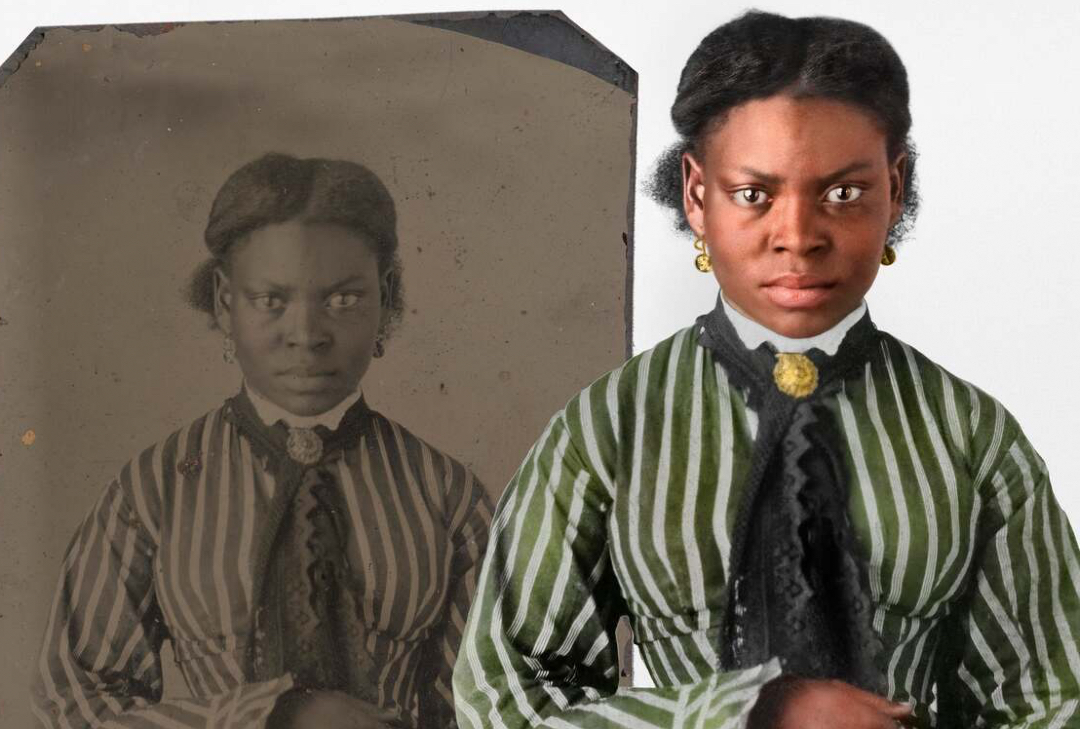Artist Manually Restores 155-Year-Old Photo Of ‘Unidentified’ Young Black Woman

Colorized photo by Aaron “A.B.” Cannon and featured with permission, original via the Smithsonian National Museum of African American History and Culture (public domain)
We may read about it in books, but history feels like a distant world, and it’s only when figures are enlivened with detail that they become real.
Aaron “A.B.” Cannon, an artist who’s been revitalizing historical photos for almost a decade, envisions people of the past as if they were in the same room as their modern-day observer. And while there are now all kinds of amazing tools that promise to do the job quickly, that personal touch is often lost in the process. Cannon’s restorations are done 100% manually, faithfully preserving details to tell a story.
His latest work is an interpretation of a black-and-white tintype of a young Black woman in a striped dress, dated back to the late 1860s. The subject, who is photographed with her hair in an updo, is accessorized in a black scarf pinned with a brooch, along with drop earrings and rings on her right hand. The woman’s identity is unknown.
View this post on Instagram
Colorized photo by Aaron “A.B.” Cannon and featured with permission, original via the Smithsonian National Museum of African American History and Culture (public domain)
Cannon brought her image back to life by accentuating her facial features and colorizing the tintype, imagining the woman’s dress to be green and white. Her restored gaze and curly hair make her feel less like a stranger. Her eyes tell a story, and you’d wish you could hear more about it.
Previous restorations shared by Cannon include a 160-year-old portrait of an elderly couple, a tintype of Confederate soldier John Pelham who died in a cavalry engagement, and photos of Union soldiers.
View this post on Instagram
Image colorized by Aaron “A.B.” Cannon, featured with permission
View this post on Instagram
Image colorized by Aaron “A.B.” Cannon, featured with permission
These days, it’s become all too convenient to “fix” old photos in a single click. Cannon acknowledges the prowess of artificial intelligence tools, but also notes that they can be inaccurate because they lack the human eye. Oftentimes, AI fills in the gaps through guesswork, embellishing images with “data where none existed previously” such as additional freckles and moles, the artist points out.
There’s also the guilt of not doing ancestors justice in these rushed jobs, or when you add or take away beauty marks. “I instead manually apply dozens of layers of compositing to faithfully enhance, ensuring there’s not a pore or imperfection out of place,” Cannon shares.
Unfortunately, some details—like clothing color—are trapped in the past. Cannon does his best by extensively researching dyes and styles commonly used in the era, “down to the month and location,” to hopefully achieve historical accuracy. It’s an “educated guessing game,” the artist describes.
“If I’m wrong, I’m wrong,” says Cannon. “However, I feel that the commitment and effort toward faithful representation is meaningful and sets apart manual colorization from AI colorization.”
Take a look at some of Aaron “A.B.” Cannon’s other photo enhancements below, and be sure to head over to his website, Instagram, and Reddit profile for more fascinating restorations.
View this post on Instagram
Image colorized by Aaron “A.B.” Cannon, featured with permission
View this post on Instagram
Image colorized by Aaron “A.B.” Cannon, featured with permission
View this post on Instagram
Image colorized by Aaron “A.B.” Cannon, featured with permission
[via r/Damnthatsinteresting, images by A.B. Cannon and featured with permission]